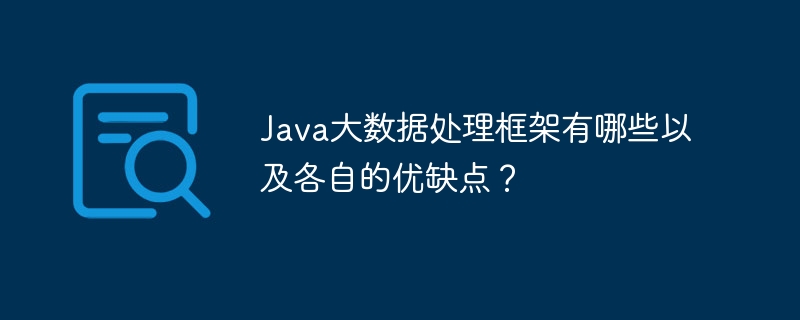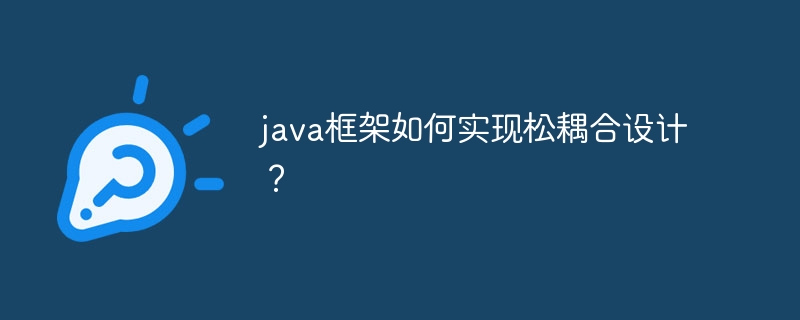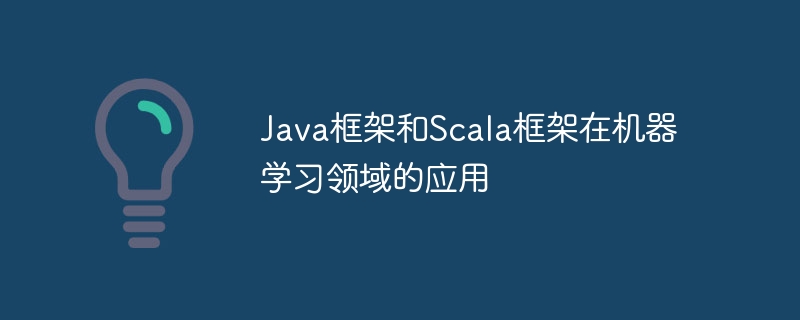Common reasons for Java framework cache invalidation include data changes, TTL expiration, manual invalidation, and concurrent updates. The processing solutions include: incremental update (for frequently updated data); cache penetration protection (to prevent directly bypassing the cache to query the database); manual invalidation (to invalidate data immediately); distributed lock (to prevent concurrent update data from being inconsistent).

Java framework cache invalidation and processing solution
Introduction
The caching mechanism is It is crucial in modern web development and can greatly improve the performance and responsiveness of applications. However, cached data may become invalid, which requires the application to take appropriate measures to handle it. In this article, we will explore common causes of cache invalidation in Java frameworks and common solutions.
Cause invalidation reasons
- Data changes: When the data in the cache is updated in the database or other persistent storage, the cache Data will become stale.
- TTL Expiration: Most caching systems set a time-to-live (TTL) value for each cache item after which the item will expire from the cache.
- Manual invalidation: There are times when applications need to proactively invalidate caches, such as when updating sensitive information or performing breaking changes.
- Concurrent updates: In a concurrent environment, multiple threads may update the same cache item at the same time, causing one of the updates to be overwritten.
Processing plan
1. Incremental update
For frequently updated data, use incremental update The mechanism can effectively reduce cache invalidation. When data changes, only the affected portion of the cache is updated, not the entire item. For example, you can use the @CachePut annotation to implement Spring's incremental updates.
@CachePut(value = "userCache", key = "#user.id")
public User updateUser(User user) {
// ... 更新数据库并返回更新后的用户
}2. Cache penetration protection
Cache penetration refers to directly bypassing the cache and querying the database when the target data cannot be queried. To prevent cache penetration, bloom filters or second-level caches can be used to intercept such requests.
3. Manual invalidation
When you need to invalidate cached data immediately, you can use the manual invalidation method provided by the cache API. For example, the Cache.evict method in Spring Cache can be used to explicitly invalidate a cache entry.
4. Distributed lock
In a concurrent environment, distributed locks can be used to ensure that the same cache item is not updated by multiple threads at the same time. By obtaining the lock before updating the cache item, you can prevent data inconsistencies caused by concurrent updates.
Practical Case
Consider the shopping basket example of an e-commerce website. When a user adds or removes items from the shopping basket, the website needs to update the shopping basket cache. Since the shopping basket data is updated frequently, using the incremental update mechanism can optimize cache performance.
@Cacheable(value = "shoppingCartCache", key = "#userId")
public ShoppingCart getShoppingCartForUser(Long userId) {
// ... 查询数据库并返回购物车
}
@CachePut(value = "shoppingCartCache", key = "#userId")
public ShoppingCart updateShoppingCart(Long userId, ShoppingCart cart) {
// ... 更新数据库和购物篮缓存
}This example uses Spring Cache to implement incremental updates, which only updates the affected part of the shopping cart cache (that is, the items that have been added or deleted), without affecting the entire shopping cart.
Conclusion
Cache invalidation is a common problem in the Java framework caching mechanism. Understanding the causes of failures and adopting appropriate solutions are critical to ensuring application performance and data consistency.
The above is the detailed content of Java framework cache invalidation and solutions. For more information, please follow other related articles on the PHP Chinese website!
 负载均衡策略在Java框架性能优化中的运用May 31, 2024 pm 08:02 PM
负载均衡策略在Java框架性能优化中的运用May 31, 2024 pm 08:02 PM负载均衡策略在Java框架中至关重要,用于高效分布请求。根据并发情况,不同的策略具有不同的性能表现:轮询法:低并发下性能稳定。加权轮询法:低并发下与轮询法性能相似。最少连接数法:高并发下性能最佳。随机法:简单但性能较差。一致性哈希法:平衡服务器负载。结合实战案例,本文说明了如何根据性能数据选择合适的策略,以显著提升应用性能。
 Java框架的扩展性和维护成本如何对比?May 31, 2024 am 09:25 AM
Java框架的扩展性和维护成本如何对比?May 31, 2024 am 09:25 AM在选择Java框架时,SpringFramework以其高扩展性见长,但随复杂度提升,维护成本也随之增加。相反,Dropwizard维护成本通常较低,但扩展能力较弱。开发者应根据特定需求评估框架。
 Java大数据处理框架有哪些以及各自的优缺点?Apr 19, 2024 pm 03:48 PM
Java大数据处理框架有哪些以及各自的优缺点?Apr 19, 2024 pm 03:48 PM对于大数据处理,Java框架包括ApacheHadoop、Spark、Flink、Storm和HBase。Hadoop适用于批处理,但实时性较差;Spark性能高,适合迭代处理;Flink实时处理流式数据;Storm流式处理容错性好,但难以处理状态;HBase是NoSQL数据库,适用于随机读写。具体选择取决于数据需求和应用程序特性。
 java框架如何实现松耦合设计?May 31, 2024 pm 05:57 PM
java框架如何实现松耦合设计?May 31, 2024 pm 05:57 PMJava框架通过采用接口与实现、依赖注入、事件驱动架构和服务定位器模式来实现松耦合设计。这些机制允许组件独立于其实现和直接引用而交互,从而提高了可维护性和可伸缩性。在SpringBootRESTAPI等实战场景中,依赖注入和接口的结合使控制器能够轻松使用UserService的任何实现,而无需硬编码依赖性。
 JPA还是MyBatis:选择合适的ORM工具的准则Feb 22, 2024 pm 09:57 PM
JPA还是MyBatis:选择合适的ORM工具的准则Feb 22, 2024 pm 09:57 PMJPA还是MyBatis:选择合适的ORM工具的准则,需要具体代码示例引言:在现代软件开发中,使用ORM(对象关系映射)工具是非常常见的。ORM工具能够将关系型数据库中的表与对象模型间进行映射,大大简化了开发过程。然而,在选择使用哪个ORM工具时,很多开发者常常感到困惑。本文将讨论如何选择适合的ORM工具,重点比较JPA和MyBatis,并给出具体的代码示例
 深入了解Java框架技术栈:探索Spring MVC、Hibernate、MyBatis等常用Java框架Dec 26, 2023 pm 12:50 PM
深入了解Java框架技术栈:探索Spring MVC、Hibernate、MyBatis等常用Java框架Dec 26, 2023 pm 12:50 PMJava框架技术栈:介绍常用的Java框架,如SpringMVC、Hibernate、MyBatis等随着Java的不断发展,越来越多的框架被开发出来以简化开发过程。其中,SpringMVC、Hibernate、MyBatis等是Java开发中最常用的框架之一。本文将介绍这些框架的基本概念和使用方法,帮助读者更好地理解和应用这些框架。第一,我们来介绍Sp
 golang函数缓存失效场景及处理策略May 05, 2024 am 08:00 AM
golang函数缓存失效场景及处理策略May 05, 2024 am 08:00 AM在Go语言中,函数缓存失效场景包括:参数改变、全局变量修改、程序重新部署、并发修改。处理策略包括:1.惰性计算(首次调用执行计算并缓存结果);2.过期策略(定期检查缓存结果有效性);3.通知机制(订阅事件或消息来自动失效缓存);4.排除失效场景(修改代码逻辑或引入其他技术)。实战案例:电商网站获取产品价格的函数,可使用过期策略定期检查价格变化,并使用锁机制防止并发修改。
 Java框架和Scala框架在机器学习领域的应用May 31, 2024 pm 12:43 PM
Java框架和Scala框架在机器学习领域的应用May 31, 2024 pm 12:43 PMJava和Scala语言在机器学习中广泛使用。本文介绍了以下Java和Scala框架:Java:Weka(提供机器学习算法和工具)、H2O(分布式内存内机器学习平台)Scala:SparkMLlib(分布式计算库的一部分,提供机器学习算法)、MLpipe(端到端管道库)这些框架可简化机器学习模型构建、提高训练效率、实现可扩展性和生产部署。选择合适的框架取决于项目需求和应用程序的规模和复杂性。


Hot AI Tools

Undresser.AI Undress
AI-powered app for creating realistic nude photos

AI Clothes Remover
Online AI tool for removing clothes from photos.

Undress AI Tool
Undress images for free

Clothoff.io
AI clothes remover

AI Hentai Generator
Generate AI Hentai for free.

Hot Article

Hot Tools

Zend Studio 13.0.1
Powerful PHP integrated development environment

EditPlus Chinese cracked version
Small size, syntax highlighting, does not support code prompt function

Dreamweaver Mac version
Visual web development tools

Atom editor mac version download
The most popular open source editor

mPDF
mPDF is a PHP library that can generate PDF files from UTF-8 encoded HTML. The original author, Ian Back, wrote mPDF to output PDF files "on the fly" from his website and handle different languages. It is slower than original scripts like HTML2FPDF and produces larger files when using Unicode fonts, but supports CSS styles etc. and has a lot of enhancements. Supports almost all languages, including RTL (Arabic and Hebrew) and CJK (Chinese, Japanese and Korean). Supports nested block-level elements (such as P, DIV),






